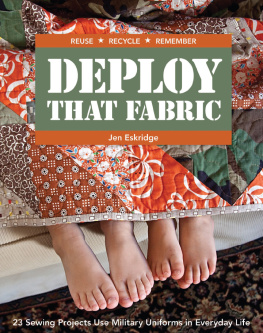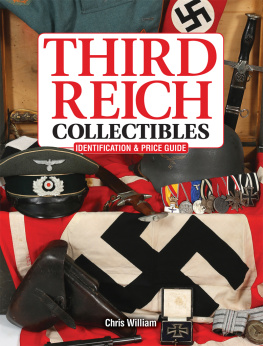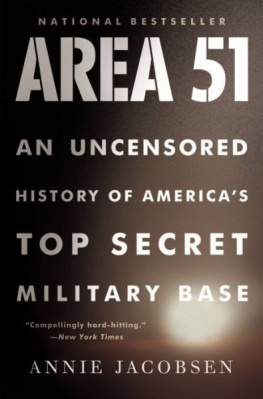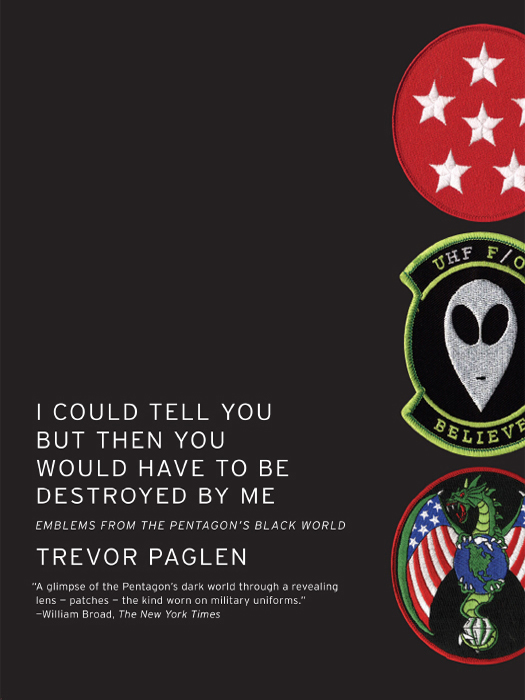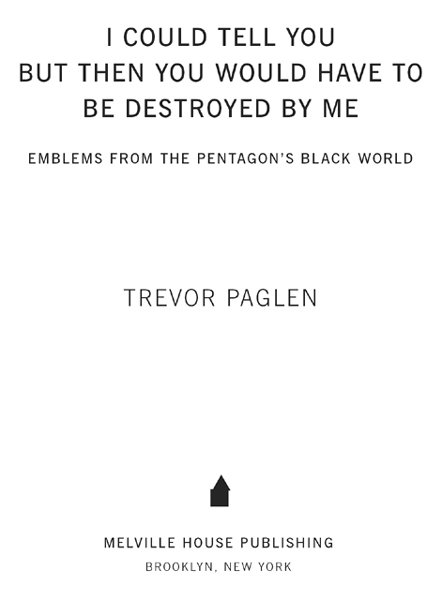Praise for Trevor Paglen and I COULD TELL YOU
A fascinating set of shoulder patches designed for the Pentagons Black Ops programs.
Stephen Colbert, The Colbert Report
A glimpse of [the Pentagons] dark world through a revealing lenspatchesthe kind worn on military uniforms The book offers not only clues into the nature of the secret programs, but also a glimpse of zealous male bonding among the presumed elite of the military-industrial complex. The patches often feel like fraternity pranks gone ballistic.
William Broad, The New York Times
A fresh approach to secret government. It shows that these secret programs have their own culture, vocabulary and even sense of humor.
Steven Aftergood, The Federation of American Scientists
Gives readers a peek into the shadows Department of Defense spokesman Bob Mehal told Newsweek that it would not be prudent to comment on what patches did or did not represent classified units. Thats OK. Some mysteries are more fun when they stay unsolved.
Karen Pinchin, Newsweek
An impressive collection.
Justin Rood, ABC News
An art book that presents peculiar shoulder patches created for the weird and top secret programs funded by the Pentagons black budget an achievement.
Timothy Buckwalter, San Francisco Chronicle
I was fascinated [Paglen] has assembled about 40 colorful patch insignia from secret, military black programs that are hardly ever discussed in public. He has plenty of regalia from the real denizens of Area 51.
Alex Beam, The Boston Globe
Some of the worst crimes in the American landscape are hiding in plain sight, and nobody has ever pursued them more thoroughly or explained them more chillingly and engagingly than Trevor Paglen. What he is doing is important, fascinating, and groundbreaking.
Rebecca Solnit, author of Wanderlust
The iconography of the United States military. Not the mainstream military, with its bars and ribbons and medals, but the secret or black projects world, which may or may not involve contacting aliens, building undetectable spy aircraft, and experimenting with explosives that could make atomic bombs look like firecrackers. Here, mysterious characters and cryptic symbols hint at intrigue much deeper than rank, company, and unit.
UTNE Reader
Of course, issuing patches for a covert operation sounds like a joke but truth be told, these days everything is branded. Military symbols are frequently replete with heraldic imagerysome rooted in history, others based on contemporary popular arts that feature comic charactersbut these enigmatic dark-op images, in some cases probably designed by the participants themselves, are more personal, and also more disturbing, than most.
Steven Heller, The New York Times Book Review
Trevor Paglen gets into the black heart of Americas black sites. There is no better guide to this great American mystery. What goes on inside these bases will determine the future of warfareand who we arefor the rest of the century.
Robert Baer, former case officer at the CIA and author of See No Evil: The True Story of a Ground Soldier in the CIAs War on Terrorism
Contents
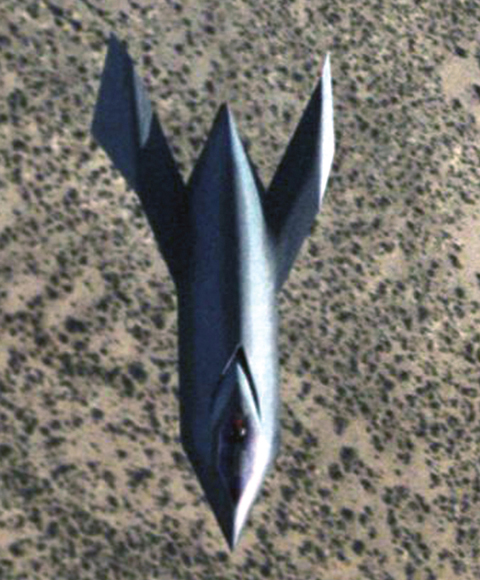
BoeingMcDonnell Douglas Bird of Prey advanced technology demonstrator was first flown in 1996. Its existence was declassified in 2002. Credit: USAF
INTRODUCTION
I began taking patches and military iconography seriously a number of years ago while visiting Californias Antelope Valley in the westernmost region of the Mojave Desert. The Antelope Valley is the nerve center of the United States military aviation industry and home to the Air Force Flight Test Center at Edwards Air Force Base. Made famous by the film The Right Stuff, Edwards is where Chuck Yeager broke the sound barrier in 1947, where Pete Knight pushed the experimental X-15 rocket plane towards Mach 7 twenty years later, and where the space shuttle Columbia landed after its first space flight in 1981. The Flight Test Centers motto Ad Inexplorata (Into the Unknown) speaks to the history of experimental aviation research that defines the region. On that particular day, I was visiting Peter Merlin, an aerospace archaeologist with a penchant for tracking down historic aircraft crash sites and a knowledgeable researcher of military aviation history. One of Merlins particular areas of expertise is the history of black (i.e. secret) aviation projects, which is why I had traveled to the Antelope Valley to meet him.
As we sat in his living room, Merlin told me about the history of what people in defense circles call the black world of classified projects, and recounted stories of the brief glimpses hed seen of it. He told me about the time hed spent standing on a ridgeline in the middle of the Nevada desert looking down on the Air Forces secret base near Groom Lake. He told me rumors and anecdotes about a $300 million CIA-Air Force plane that never got off the ground, about a mysterious classified demonstrator flown in the mid 1980s, and about a secret plane called the YF-113G that flew in the early 1990s. The bits of arcana he had picked up in his work were as dizzying in their incompleteness as they were fascinating.
After spending the better part of an afternoon chatting, Merlin motioned for me to follow him upstairs and into his office. There, I found myself surrounded by the refuse, leftovers, and bits of debris that a half-century of secret aircraft projects had left behind. Hed recovered metal shards from shattered stealth fighters by locating the remote sites where they had crashed, and found the in-flight recorder from an A-12 spy plane in a local junkyard. There were mugs, pins, and other memorabilia preserved in frames, glass-enclosed shelves, and well-kept vitrines. I trust evidence, Merlin said. People can lie. Evidence doesnt. He handed me a thick folder stuffed with documents. Heres the Standard Operating Procedure for Area 51, the operations manual for a secret Air Force Base, most people just assume that everything is classified so they dont take the time to look, he said. Indeed, a few months later, I would obtain my own copy from the ever-helpful staff at the National Archives. And this, he told me as he opened a notebook filled with scanned images of military patches, is called patch intel.
Id seen some of the images he had reproduced in his notebooks before, lining the walls of test pilot watering holes, on the living room walls of other people Id talked to, and on the pages of in-house military history publications. They were a part of the militarys everyday culture. Id always found the skulls, lightning bolts, and dragons that adorned these patches to be fairly unremarkable, but Merlin saw something in them that I hadnt noticedthe symbols they contained were far from random. The lightning bolts, he told me, meant specific things in specific contexts; the numbers of stars on an image might represent a unit number or an operating location; the symbols on a patch could be clues to the purpose of a hidden program or a cover story designed to divert attention away from a program. These symbols, Merlin explained to me, were a language. If you could begin to learn its grammar, you could get a glimpse into the secret world itself.


